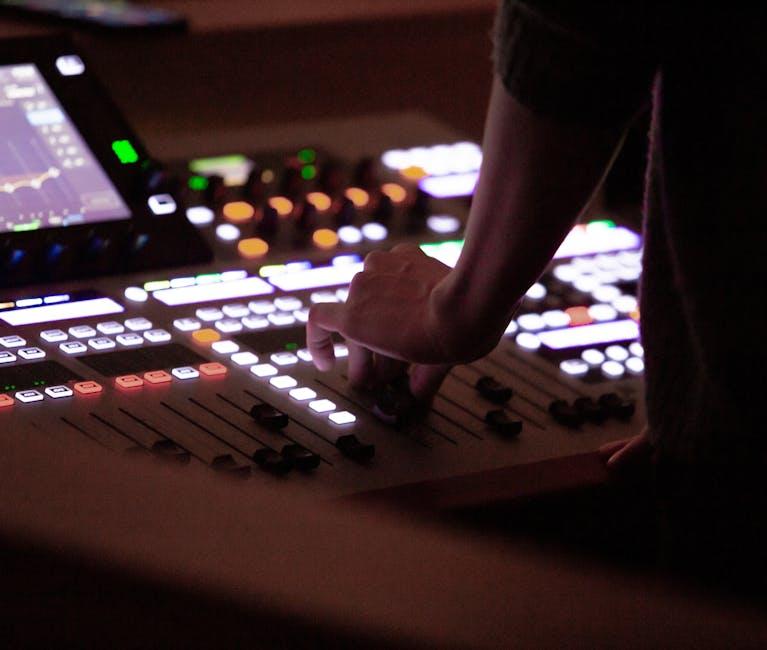
In the ever-evolving landscape of technology, few realms have witnessed transformation as profound as that of audio. “From Grooves to Digital Waves: Audio Tech’s Rise” delves into this captivating journey, tracing the shift from the warm crackles of vinyl records to the pristine clarity of digital soundscapes. this evolution not only reflects advancements in engineering and innovation but also mirrors changes in how we experience and interact with music and audio content. As we navigate through the milestones of audio technology, we uncover the interplay between tradition and modernity, exploring how each wave of progress shapes our auditory experiences today and lays the foundation for tomorrow’s sonic frontiers.
Table of Contents
- Evolution of Sound Recording From Vinyl to streaming
- The Impact of Digital Innovation on Audio Quality
- Emerging Technologies shaping the Future of Music Production
- Strategies for adapting to the Digital Audio Landscape
- Concluding Remarks

Evolution of Sound recording From Vinyl to Streaming
The journey of sound recording is a testament to human ingenuity and the relentless pursuit of better audio experiences. It all began with vinyl records, where grooves etched into discs captured music in analog form. These records dominated the mid-20th century, offering rich, warm tones that enthusiasts still cherish today. Though, vinyl’s physical limitations—such as susceptibility to wear and limited portability—eventually paved the way for innovative breakthroughs.The late 20th century witnessed the rise of magnetic tape with cassette tapes, introducing greater convenience and portability. This era was swiftly followed by the compact disc (CD), which promised digital clarity and durability. The transition from analog to digital not only enhanced sound quality but also revolutionized how music was distributed and consumed.The advent of MP3s and digital downloads further transformed the landscape, making music more accessible than ever.
In the 21st century, streaming services have redefined the listening experience, offering vast libraries of music at our fingertips. Unlike physical media, streaming provides instant access, personalized recommendations, and seamless integration across devices. This shift reflects broader technological trends towards connectivity and on-demand content, illustrating how sound recording continues to evolve in response to changing consumer needs.
| Era | Format | Introduction Year | Key Feature |
|—————|—————–|——————-|————————|
| Analog | Vinyl Records | 1948 | Warm,rich sound |
| Portable | Cassette Tapes | 1963 | portability |
| digital | CDs | 1982 | Digital clarity |
| Online | MP3s/Downloads | 1999 | Easy distribution |
| On-Demand | Streaming | 2008 | Instant access |
The Impact of Digital Innovation on Audio Quality
The evolution from analog to digital technology has revolutionized the landscape of audio quality, ushering in an era where clarity and precision are paramount.Digital innovations have enabled audio engineers and enthusiasts alike to manipulate sound with unprecedented accuracy, eliminating many of the distortions and limitations inherent in analog systems. High-resolution audio formats, as an example, offer listeners a richer and more detailed sonic experience, capturing nuances that were previously lost in standard recordings.
Moreover, advancements in digital signal processing (DSP) have played a crucial role in enhancing audio quality. techniques such as noise reduction, echo cancellation, and dynamic range compression allow for cleaner and more balanced sound, whether in music production, live performances, or everyday listening. Spatial audio technologies, powered by digital innovation, create immersive soundscapes that mimic real-world environments, providing a more engaging and lifelike auditory experience.
The integration of artificial intelligence and machine learning in audio technology further pushes the boundaries of what’s possible. These technologies enable intelligent mastering, real-time audio enhancement, and personalized sound settings that adapt to individual preferences and environments.As digital innovation continues to advance, the potential for even greater improvements in audio quality remains vast, promising a future where sound is not only heard but profoundly experienced.
| Digital innovation | Impact on Audio Quality |
|————————|—————————————|
| High-Resolution Audio | enhanced clarity and detail |
| Digital Signal Processing (DSP) | Reduced noise and balanced sound |
| Spatial Audio | immersive and realistic soundscapes |
| AI-Driven Mastering | Personalized and optimized audio |
| Real-Time enhancement | Adaptive sound in various environments|
Emerging Technologies Shaping the Future of Music Production
The landscape of music production is undergoing a remarkable transformation, driven by cutting-edge technologies that expand the boundaries of creativity and efficiency.Artificial Intelligence (AI) is at the forefront, enabling producers to generate complex arrangements, suggest innovative sounds, and even master tracks with unprecedented precision. Virtual Reality (VR) and Augmented Reality (AR) are revolutionizing the way artists interact with their music, allowing immersive studio experiences and interactive performances that engage audiences like never before.
Blockchain technology is also making its mark, offering transparent and secure ways to manage royalties and intellectual property rights, ensuring that creators are fairly compensated for their work. Additionally, advancements in cloud-based platforms are facilitating seamless collaboration across the globe, breaking down geographical barriers and fostering a more inclusive and diverse music creation environment.These technologies not only enhance the technical aspects of production but also empower artists to explore new creative avenues,redefining the future of music.
| Technology | Impact on Music production |
|———————-|—————————————————–|
| Artificial Intelligence | Automates mastering, suggests harmonic progressions |
| Virtual Reality | Immersive studio environments, interactive performances |
| Blockchain | Secure royalty management, transparent IP rights |
| Cloud Platforms | global collaboration, real-time project sharing |
| Augmented Reality | Enhanced live performances, interactive audience experiences |
As these emerging technologies continue to evolve, they promise to unlock new potentials for musicians and producers alike, paving the way for innovative soundscapes and dynamic production techniques that will define the next era of music.
Strategies for adapting to the Digital Audio Landscape
As the audio industry sails deeper into the digital era, adapting to rapid technological advancements is crucial for staying relevant and competitive. Embracing these changes not only enhances production quality but also opens new avenues for creativity and audience engagement. here are key strategies to navigate and thrive in the evolving digital audio landscape:
1. Embrace Cutting-Edge Technology:
Stay updated with the latest software and hardware innovations. Investing in high-quality digital audio workstations (DAWs), plugins, and recording equipment can substantially improve sound quality and streamline production processes. Regularly attending workshops and webinars can also keep you informed about emerging tools and techniques.
2. Focus on Digital Marketing and Distribution:
Leverage online platforms to distribute and promote your audio content.Utilizing social media, streaming services, and podcasts can expand your reach and connect you with a global audience. Developing a strong online presence through a dedicated website and engaging content can enhance visibility and attract potential listeners or clients.3. Foster Collaborative Networks:
Building a network of digital audio professionals can lead to valuable collaborations and knowledge sharing. Participate in online forums, virtual conferences, and industry groups to connect with peers, mentors, and potential partners.Collaborative projects can inspire innovation and provide support in navigating digital challenges.
4. Prioritize Continuous Learning:
The digital audio landscape is constantly evolving, making ongoing education essential. Enroll in courses, pursue certifications, and stay curious about new trends and methodologies. Adaptability through continuous learning ensures you remain proficient and competitive in the dynamic audio industry.
| Strategy | Action Steps | Benefits |
|—————————-|———————————————–|—————————————|
| Embrace Cutting-Edge Tech | Invest in modern DAWs and plugins | Enhanced sound quality and efficiency |
| Digital Marketing | utilize social media and streaming platforms | Increased reach and audience engagement |
| foster Collaboration | Join online audio communities | Access to diverse ideas and support |
| continuous Learning | Attend webinars and take online courses | Stay updated with industry trends |
Implementing these strategies will empower audio professionals to effectively navigate the digital landscape,harness new opportunities,and achieve sustained growth in an ever-changing industry.
Concluding Remarks
As the echoes of vinyl’s timeless grooves gracefully dissolve into the seamless currents of digital waves,the journey of audio technology continues to unfold. This evolution, marked by relentless innovation and a quest for clarity, bridges the nostalgic warmth of the past with the precision of the future. Whether through the crackle of a cherished record or the pristine streams of modern platforms, the essence of sound remains a worldwide language. As we navigate this dynamic landscape, one thing remains certain: the harmony between tradition and technology will keep the symphony of audio advancement playing on, inviting us all to listen, engage, and appreciate the ever-changing rhythms that shape our auditory experiences.





















